9/11/06 (Sunday): Sorry it took so long to finalize this post. We were busy putting in new tile in the camper and then I had some trouble with the blogger website. If you've been looking at it today or late yesterday, it was just a draft, so read on! This blog is about our adventure at Baxter State Park.
We left Wednesday morning and stopped at a little country diner near Stockton Springs for breakfast. I had homemade hash and eggs with homemade bread. Each diner has a slightly different version of hash up here, and all of it is good. Wiley had his usual pancakes. He's suffering now that blueberries are out of season, because blueberry pancakes are his favorite, and Mainers will not use frozen berries!
We were expecting a phone interview at 9:15 AM from The Nature Conservancy folks about the job at Tiger Creek Preserve, but unbeknownst to us, they'd emailed us to change the time! We also did not realize that we weren't getting a good satellite connection, and when they tried to call us, they kept getting our answering service. We sat in the parking lot for about 15 minutes waiting and wondering, but finally went on our way. It all worked out fine and we finally touched base with them via a pay phone and had our interview. They called the next day and left the message that we were hired. We're really excited about this job--once again it was our first choice of assignments! We'll start around October 20. It will be good to be close to our family and friends again. We've had a lot of fun in Maine, but we're ready to come home.
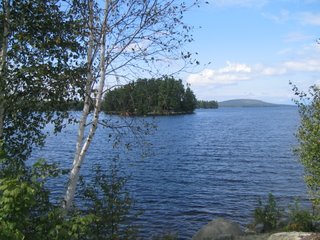 Our next stop was for a picnic at a roadside picnic area. Maine has a lot of these, and most of them are quite lovely, with bathrooms and often with nice views. This one was beside a huge lake studded with islands and expensive but rustic "cabins."
Our next stop was for a picnic at a roadside picnic area. Maine has a lot of these, and most of them are quite lovely, with bathrooms and often with nice views. This one was beside a huge lake studded with islands and expensive but rustic "cabins."
 We stopped again at the Jo-Mary Multiuse Forest. We walked around the ruins of the Kathadin Iron Works, which was a big operation in the 1880's. All that remains now are the stone furnace and one kiln. The raw iron ore was superheated in the furnace using charcoal made in the kilns. Limestone was added, which caused a chemical reaction that produced molten iron. The molten iron flowed out the bottom into a casting shed, where molds were dug in the sand. As the molten iron flowed out it made a sound like a pig, hence the name for the product: pig iron. The pig iron was loaded onto a train and sent to Bangor, where it was loaded onto ships and sent all over the United States.
We stopped again at the Jo-Mary Multiuse Forest. We walked around the ruins of the Kathadin Iron Works, which was a big operation in the 1880's. All that remains now are the stone furnace and one kiln. The raw iron ore was superheated in the furnace using charcoal made in the kilns. Limestone was added, which caused a chemical reaction that produced molten iron. The molten iron flowed out the bottom into a casting shed, where molds were dug in the sand. As the molten iron flowed out it made a sound like a pig, hence the name for the product: pig iron. The pig iron was loaded onto a train and sent to Bangor, where it was loaded onto ships and sent all over the United States.
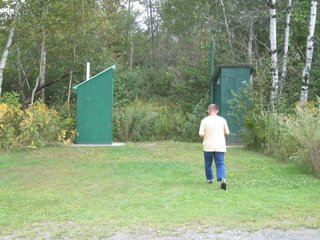 The area was very primitive (including the bathroom facilities). Mag--thought you'd like this shot of Wiley to add to your outhouse photo collection!
The area was very primitive (including the bathroom facilities). Mag--thought you'd like this shot of Wiley to add to your outhouse photo collection!
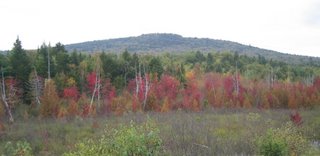 As we approached Baxter State Park, the views were spectacular. The maples were just beginning to turn, there were meadows full of wild flowers, ponds and lakes, marshy areas and always in the distance views of Mt. Kathadin and Mt. Doubletop.
As we approached Baxter State Park, the views were spectacular. The maples were just beginning to turn, there were meadows full of wild flowers, ponds and lakes, marshy areas and always in the distance views of Mt. Kathadin and Mt. Doubletop.
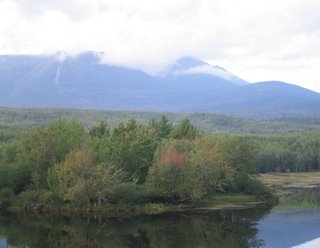 The mountains in this area are considerably higher than those near us--3,000-5,000 feet. Baxter Peak is Maine's tallest (5,267 feet). And, of course, Mt. Katahdin is familiar to all hikers because it's where the Appalachian Trail terminates. The tops of the mountains are bare granite, the midslopes have fir and spruce trees and the lower slopes are mixed hardwood forests. The tops of the tallest mountains are alpine tundra, which is a unique ecosystem with dwarf vegetation that is adapted to survive extreme exposure of heavy snow and frost, cool summers, strong and drying winds, and intense sunlight. We did not visit this area because the hiking is strenuous and one has to be very well prepared for possibly harsh conditions.
The mountains in this area are considerably higher than those near us--3,000-5,000 feet. Baxter Peak is Maine's tallest (5,267 feet). And, of course, Mt. Katahdin is familiar to all hikers because it's where the Appalachian Trail terminates. The tops of the mountains are bare granite, the midslopes have fir and spruce trees and the lower slopes are mixed hardwood forests. The tops of the tallest mountains are alpine tundra, which is a unique ecosystem with dwarf vegetation that is adapted to survive extreme exposure of heavy snow and frost, cool summers, strong and drying winds, and intense sunlight. We did not visit this area because the hiking is strenuous and one has to be very well prepared for possibly harsh conditions.
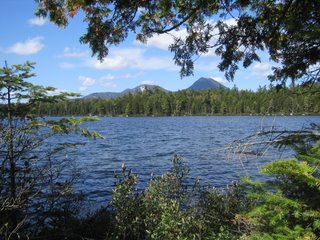 The park is a wilderness of 204,733 acres. The only other traffic we saw was trucks laden down with huge logs. I don't think they allow logging in the state park, but they must allow it in nearby areas, because day and night the trucks went by--always loaded down headed southbound and empty headed northbound.
The park is a wilderness of 204,733 acres. The only other traffic we saw was trucks laden down with huge logs. I don't think they allow logging in the state park, but they must allow it in nearby areas, because day and night the trucks went by--always loaded down headed southbound and empty headed northbound.
Baxter State Park was a gift to the state of Maine by a former governor (Percival Baxter). He purchased land over the years and designated it with the stipulation that the area be kept forever as a wildlife sanctuary and in its natural wild state. This included over 41 miles of roads (called "tote roads,") which are dirt and only minimally maintained. One of the signs we saw quoted Baxter as saying: "Man is born to die, his works are short-lived. Buildings crumble, monuments decay, wealth vanishes. But Kathadin in all its glory forever shall remain the mountain of the people of Maine." There are ten campgrounds in the park, but they are so primitive that they don't even have potable water, so we stayed in a nearby private campground with potable water and hot showers!
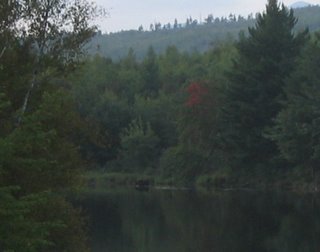 After we set up our campsite, we went on a moose hunt! We were given directions for a lovely drive on Golden Road. The road was elevated above a marshy area with forests and, of course, the mountains in the background. We drove past numerous ponds, stopping and looking frequently for our elusive moose. Finally, at the last stop, Wiley spotted one! We both got a good look at him with the binoculars. Unfortunately, our little camera didn't get a very clear shot of him (I had to enlarge him too much). But, just to prove we did it, here's our first moose!
After we set up our campsite, we went on a moose hunt! We were given directions for a lovely drive on Golden Road. The road was elevated above a marshy area with forests and, of course, the mountains in the background. We drove past numerous ponds, stopping and looking frequently for our elusive moose. Finally, at the last stop, Wiley spotted one! We both got a good look at him with the binoculars. Unfortunately, our little camera didn't get a very clear shot of him (I had to enlarge him too much). But, just to prove we did it, here's our first moose!
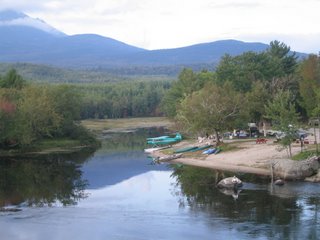 The moose was at the Abol Bridge beside this gorgeous little campground. (This is not the campground we stayed at, but I'd love to go back and camp there.) I thought this picture summed up our whole Maine experience--a float plane, a fly fisherman, a moose, mountains, a gorgeous white water stream--life is good!
The moose was at the Abol Bridge beside this gorgeous little campground. (This is not the campground we stayed at, but I'd love to go back and camp there.) I thought this picture summed up our whole Maine experience--a float plane, a fly fisherman, a moose, mountains, a gorgeous white water stream--life is good!
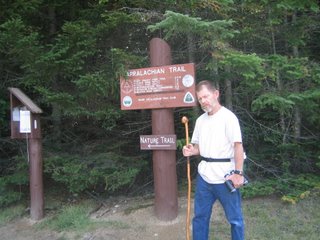 Thursday morning we headed into the state park. At the ranger station, we requested information about some easy hikes and were directed to Daicey Pond. We hiked a section of the Appalachian Trail which connected to the Grassy Pond Trail. We continued to look (unsuccessfully this time) for moose. The trails were well maintained and the scenery was excellent.
Thursday morning we headed into the state park. At the ranger station, we requested information about some easy hikes and were directed to Daicey Pond. We hiked a section of the Appalachian Trail which connected to the Grassy Pond Trail. We continued to look (unsuccessfully this time) for moose. The trails were well maintained and the scenery was excellent. 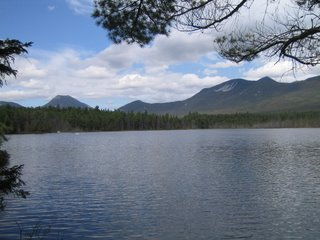
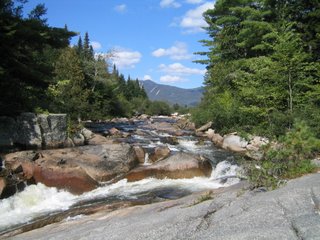 We returned to the truck and had a quick lunch and then hiked another section of the Appalachian Trail toward Little Niagara and Big Niagara. There was a large group of hikers who had come all the way from Georgia on the trail and were almost to the end on Mt. Kathadin.
We returned to the truck and had a quick lunch and then hiked another section of the Appalachian Trail toward Little Niagara and Big Niagara. There was a large group of hikers who had come all the way from Georgia on the trail and were almost to the end on Mt. Kathadin.
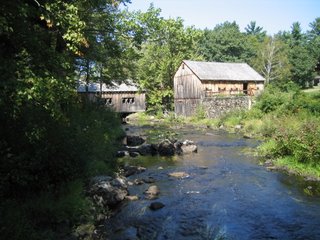 We hated to say goodbye to Baxter State Park on Friday, so we planned some fun for the trip home. We took back roads and stopped along the way at a living history museum called Leonard's Mills (in Bradley, Maine). This museum centers around the logging and lumbering history in Maine. The centerpiece is this water-powered sawmill, which was just fascinating to me (the structure to the left of it is a covered bridge. I couldn't get a shot of the water wheel, so this is the other side of the mill.)
We hated to say goodbye to Baxter State Park on Friday, so we planned some fun for the trip home. We took back roads and stopped along the way at a living history museum called Leonard's Mills (in Bradley, Maine). This museum centers around the logging and lumbering history in Maine. The centerpiece is this water-powered sawmill, which was just fascinating to me (the structure to the left of it is a covered bridge. I couldn't get a shot of the water wheel, so this is the other side of the mill.)
Water powered mills have been around (in Europe) since about the 13th century, possibly longer. Put in overly simplistic terms, the water turns a big wheel, which activates rods that push a saw up and down. By controlling the speed of the water, they can control the speed of the saw. The logs were floated into the mill pond, then pushed onto maple rails that held the log in position. A clamp and pushing device (also controlled by rods connected to the wheel) pushed the log through the saw as it went up and down. They could control the size of the planks pretty precisely.
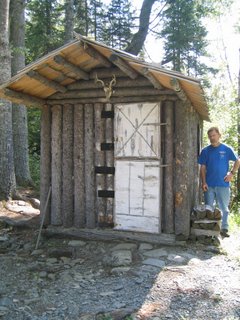 There were many other interesting exhibits at this living history museum. This tiny building is a trapper's line cabin -- a place where fur trappers stayed when they were checking their lines. They were spaced a day's hike apart. Inside there was a central fire ring with a chimney in the roof, a cot, a shelf with some canned food and some hooks on the wall. Primitive, but get a load of the gorgeous door paneled in birch bark!
There were many other interesting exhibits at this living history museum. This tiny building is a trapper's line cabin -- a place where fur trappers stayed when they were checking their lines. They were spaced a day's hike apart. Inside there was a central fire ring with a chimney in the roof, a cot, a shelf with some canned food and some hooks on the wall. Primitive, but get a load of the gorgeous door paneled in birch bark!
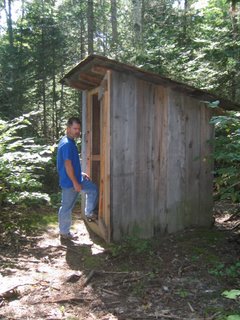 Mag -- here's another outhouse for your collection (yes, both were real, working outhouses). They were common and very welcome in this area where there are no stores, motels or commercial buildings of any kind.
Mag -- here's another outhouse for your collection (yes, both were real, working outhouses). They were common and very welcome in this area where there are no stores, motels or commercial buildings of any kind.
We were expecting a phone interview at 9:15 AM from The Nature Conservancy folks about the job at Tiger Creek Preserve, but unbeknownst to us, they'd emailed us to change the time! We also did not realize that we weren't getting a good satellite connection, and when they tried to call us, they kept getting our answering service. We sat in the parking lot for about 15 minutes waiting and wondering, but finally went on our way. It all worked out fine and we finally touched base with them via a pay phone and had our interview. They called the next day and left the message that we were hired. We're really excited about this job--once again it was our first choice of assignments! We'll start around October 20. It will be good to be close to our family and friends again. We've had a lot of fun in Maine, but we're ready to come home.
 Our next stop was for a picnic at a roadside picnic area. Maine has a lot of these, and most of them are quite lovely, with bathrooms and often with nice views. This one was beside a huge lake studded with islands and expensive but rustic "cabins."
Our next stop was for a picnic at a roadside picnic area. Maine has a lot of these, and most of them are quite lovely, with bathrooms and often with nice views. This one was beside a huge lake studded with islands and expensive but rustic "cabins." We stopped again at the Jo-Mary Multiuse Forest. We walked around the ruins of the Kathadin Iron Works, which was a big operation in the 1880's. All that remains now are the stone furnace and one kiln. The raw iron ore was superheated in the furnace using charcoal made in the kilns. Limestone was added, which caused a chemical reaction that produced molten iron. The molten iron flowed out the bottom into a casting shed, where molds were dug in the sand. As the molten iron flowed out it made a sound like a pig, hence the name for the product: pig iron. The pig iron was loaded onto a train and sent to Bangor, where it was loaded onto ships and sent all over the United States.
We stopped again at the Jo-Mary Multiuse Forest. We walked around the ruins of the Kathadin Iron Works, which was a big operation in the 1880's. All that remains now are the stone furnace and one kiln. The raw iron ore was superheated in the furnace using charcoal made in the kilns. Limestone was added, which caused a chemical reaction that produced molten iron. The molten iron flowed out the bottom into a casting shed, where molds were dug in the sand. As the molten iron flowed out it made a sound like a pig, hence the name for the product: pig iron. The pig iron was loaded onto a train and sent to Bangor, where it was loaded onto ships and sent all over the United States. The area was very primitive (including the bathroom facilities). Mag--thought you'd like this shot of Wiley to add to your outhouse photo collection!
The area was very primitive (including the bathroom facilities). Mag--thought you'd like this shot of Wiley to add to your outhouse photo collection! As we approached Baxter State Park, the views were spectacular. The maples were just beginning to turn, there were meadows full of wild flowers, ponds and lakes, marshy areas and always in the distance views of Mt. Kathadin and Mt. Doubletop.
As we approached Baxter State Park, the views were spectacular. The maples were just beginning to turn, there were meadows full of wild flowers, ponds and lakes, marshy areas and always in the distance views of Mt. Kathadin and Mt. Doubletop. The mountains in this area are considerably higher than those near us--3,000-5,000 feet. Baxter Peak is Maine's tallest (5,267 feet). And, of course, Mt. Katahdin is familiar to all hikers because it's where the Appalachian Trail terminates. The tops of the mountains are bare granite, the midslopes have fir and spruce trees and the lower slopes are mixed hardwood forests. The tops of the tallest mountains are alpine tundra, which is a unique ecosystem with dwarf vegetation that is adapted to survive extreme exposure of heavy snow and frost, cool summers, strong and drying winds, and intense sunlight. We did not visit this area because the hiking is strenuous and one has to be very well prepared for possibly harsh conditions.
The mountains in this area are considerably higher than those near us--3,000-5,000 feet. Baxter Peak is Maine's tallest (5,267 feet). And, of course, Mt. Katahdin is familiar to all hikers because it's where the Appalachian Trail terminates. The tops of the mountains are bare granite, the midslopes have fir and spruce trees and the lower slopes are mixed hardwood forests. The tops of the tallest mountains are alpine tundra, which is a unique ecosystem with dwarf vegetation that is adapted to survive extreme exposure of heavy snow and frost, cool summers, strong and drying winds, and intense sunlight. We did not visit this area because the hiking is strenuous and one has to be very well prepared for possibly harsh conditions.  The park is a wilderness of 204,733 acres. The only other traffic we saw was trucks laden down with huge logs. I don't think they allow logging in the state park, but they must allow it in nearby areas, because day and night the trucks went by--always loaded down headed southbound and empty headed northbound.
The park is a wilderness of 204,733 acres. The only other traffic we saw was trucks laden down with huge logs. I don't think they allow logging in the state park, but they must allow it in nearby areas, because day and night the trucks went by--always loaded down headed southbound and empty headed northbound.Baxter State Park was a gift to the state of Maine by a former governor (Percival Baxter). He purchased land over the years and designated it with the stipulation that the area be kept forever as a wildlife sanctuary and in its natural wild state. This included over 41 miles of roads (called "tote roads,") which are dirt and only minimally maintained. One of the signs we saw quoted Baxter as saying: "Man is born to die, his works are short-lived. Buildings crumble, monuments decay, wealth vanishes. But Kathadin in all its glory forever shall remain the mountain of the people of Maine." There are ten campgrounds in the park, but they are so primitive that they don't even have potable water, so we stayed in a nearby private campground with potable water and hot showers!
 After we set up our campsite, we went on a moose hunt! We were given directions for a lovely drive on Golden Road. The road was elevated above a marshy area with forests and, of course, the mountains in the background. We drove past numerous ponds, stopping and looking frequently for our elusive moose. Finally, at the last stop, Wiley spotted one! We both got a good look at him with the binoculars. Unfortunately, our little camera didn't get a very clear shot of him (I had to enlarge him too much). But, just to prove we did it, here's our first moose!
After we set up our campsite, we went on a moose hunt! We were given directions for a lovely drive on Golden Road. The road was elevated above a marshy area with forests and, of course, the mountains in the background. We drove past numerous ponds, stopping and looking frequently for our elusive moose. Finally, at the last stop, Wiley spotted one! We both got a good look at him with the binoculars. Unfortunately, our little camera didn't get a very clear shot of him (I had to enlarge him too much). But, just to prove we did it, here's our first moose! The moose was at the Abol Bridge beside this gorgeous little campground. (This is not the campground we stayed at, but I'd love to go back and camp there.) I thought this picture summed up our whole Maine experience--a float plane, a fly fisherman, a moose, mountains, a gorgeous white water stream--life is good!
The moose was at the Abol Bridge beside this gorgeous little campground. (This is not the campground we stayed at, but I'd love to go back and camp there.) I thought this picture summed up our whole Maine experience--a float plane, a fly fisherman, a moose, mountains, a gorgeous white water stream--life is good! Thursday morning we headed into the state park. At the ranger station, we requested information about some easy hikes and were directed to Daicey Pond. We hiked a section of the Appalachian Trail which connected to the Grassy Pond Trail. We continued to look (unsuccessfully this time) for moose. The trails were well maintained and the scenery was excellent.
Thursday morning we headed into the state park. At the ranger station, we requested information about some easy hikes and were directed to Daicey Pond. We hiked a section of the Appalachian Trail which connected to the Grassy Pond Trail. We continued to look (unsuccessfully this time) for moose. The trails were well maintained and the scenery was excellent. 
 We returned to the truck and had a quick lunch and then hiked another section of the Appalachian Trail toward Little Niagara and Big Niagara. There was a large group of hikers who had come all the way from Georgia on the trail and were almost to the end on Mt. Kathadin.
We returned to the truck and had a quick lunch and then hiked another section of the Appalachian Trail toward Little Niagara and Big Niagara. There was a large group of hikers who had come all the way from Georgia on the trail and were almost to the end on Mt. Kathadin. We hated to say goodbye to Baxter State Park on Friday, so we planned some fun for the trip home. We took back roads and stopped along the way at a living history museum called Leonard's Mills (in Bradley, Maine). This museum centers around the logging and lumbering history in Maine. The centerpiece is this water-powered sawmill, which was just fascinating to me (the structure to the left of it is a covered bridge. I couldn't get a shot of the water wheel, so this is the other side of the mill.)
We hated to say goodbye to Baxter State Park on Friday, so we planned some fun for the trip home. We took back roads and stopped along the way at a living history museum called Leonard's Mills (in Bradley, Maine). This museum centers around the logging and lumbering history in Maine. The centerpiece is this water-powered sawmill, which was just fascinating to me (the structure to the left of it is a covered bridge. I couldn't get a shot of the water wheel, so this is the other side of the mill.)Water powered mills have been around (in Europe) since about the 13th century, possibly longer. Put in overly simplistic terms, the water turns a big wheel, which activates rods that push a saw up and down. By controlling the speed of the water, they can control the speed of the saw. The logs were floated into the mill pond, then pushed onto maple rails that held the log in position. A clamp and pushing device (also controlled by rods connected to the wheel) pushed the log through the saw as it went up and down. They could control the size of the planks pretty precisely.
 There were many other interesting exhibits at this living history museum. This tiny building is a trapper's line cabin -- a place where fur trappers stayed when they were checking their lines. They were spaced a day's hike apart. Inside there was a central fire ring with a chimney in the roof, a cot, a shelf with some canned food and some hooks on the wall. Primitive, but get a load of the gorgeous door paneled in birch bark!
There were many other interesting exhibits at this living history museum. This tiny building is a trapper's line cabin -- a place where fur trappers stayed when they were checking their lines. They were spaced a day's hike apart. Inside there was a central fire ring with a chimney in the roof, a cot, a shelf with some canned food and some hooks on the wall. Primitive, but get a load of the gorgeous door paneled in birch bark! Mag -- here's another outhouse for your collection (yes, both were real, working outhouses). They were common and very welcome in this area where there are no stores, motels or commercial buildings of any kind.
Mag -- here's another outhouse for your collection (yes, both were real, working outhouses). They were common and very welcome in this area where there are no stores, motels or commercial buildings of any kind.That's it for this week's adventure. Tune in again soon. We still have a couple of adventures up our sleeves. We're going to Monhegan Island soon, among other special trips.


5 comments:
You got some beautiful shots, Joyce. I really enjoyed the way you took that somewhat "less than exciting" picture of the iron kiln and made it so interesting with the pig iron story.
However, I did not really find the moose. I saw several dark blobs that could have been a moose. Is the moose in that very dark picture, a bit to the left of center?
I have a lot of favorite pictures but I tend to agree that the campground shot is phenomenal. That one shot included so much. The plane in the background and the guy sitting on the rock just couldn't have made a more perfect shot.
Thanks--I thought this was one of my better blogs! The moose is the dark blob to the left of center in the dark shot. It's dark and blurry because it was a tiny dot in the middle of a picture that I cropped out and blew up about 400%. My little camera just doesn't have a powerful enough lens--he was pretty far away.
That campground on the river was just so idyllic it made you want to pitch a tent right away!
O.K. I found that moose after all. Now what's this about Mag collecting outhouses!!! And Wiley -- you take good pictures but you might want to consider posing in front of something other than outhouses. [Smile]
Mag has a collage of outhouse photos in her bathroom!
Those outhouse pictures are a hoot! Such beautiful scenery - will you really want to come home again? Well, maybe if you were there when it began to snow... :)
Were you on any section of the Appalachian Trail that you'd hiked many years ago?
Post a Comment